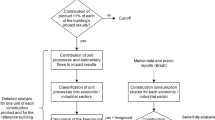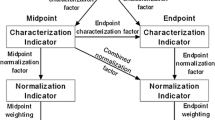Abstract
Purpose
This article proposes an approach describing relative potential toxicological performances of products and allows for comparisons with other products with identical functions. The scores derived at the substance level may be aggregated to the product level for each of the life cycle stages of the product. This approach is intended to become a tool for performance assessment of products. It provides complementary information in addition to results from LCA for environmental product declarations (EPD). This article focuses on describing the impact on human health from exposure to construction products and to their ingredients, compatible with “life cycle thinking”. Ingredient substances can be part of the intended composition or can be relevant residues like monomers in plastics or defined contaminants. The proposed approach can also describe the toxicological impact for other than construction products.
Methods
The method describes a dimensionless score suitable for ranking with three characteristics: (1) By a hazard score, it describes chemical products for different applications, e.g. for construction, with regard to the inherent toxicity for humans of their ingredients. (2) It considers exposure potentials to the product’s ingredients by a generic adjustment factor, which may modify potential health impacts. (3) It addresses not only the use stage of a product and its ingredients (e.g. as construction material in a building), but it also includes other life cycle stages of the product’s ingredients.
Results and discussion
The specific method is described which is still under testing. Therefore, no results of any application can be published so far. Since the method provides a scalable, dimensionless score of potential toxicological impacts, independent of time and location, these scores can in principle be aggregated to the building level, comparable to the life cycle assessment (LCA)-based information in an EPD. The different factors make use of the extensive toxicological and exposure data generated under REACH regulation but are not limited to these. Interpretation of such data differs from REACH.
Conclusions
The method can be further developed into a tool for product and building assessment and be provided as (voluntary) additional information in an EPD. It is recommended that the basic concept be adapted to the needs of the users of the information generated with this method (e.g. architects, building assessment) and the providers of information (manufacturers). An intense consultation process with other stakeholders should be organised to establish a final method into a guidance document for unambiguous application.


Similar content being viewed by others
Notes
DGNB: Deutsche Gesellschaft Nachhaltiges Bauen; BNB: Bewerungssystem Nachhaltiges Bauen; HQE: Haute Qualité Environnementale; BREEAM: Building Research Establishment Environmental Assessment Methodology; LEED: Leadership in Energy and Environmental Design.
EN 15804+A1:2013 “Sustainability of construction works—environmental product declarations—core rules for the product category of construction products”
CEN TC 350: European Committee for Standardisation, Technical Committee 350 Sustainability of Construction Works
ISO Guide 64:2008 (Guide for addressing environmental issues in product standards definition) states with regard to life cycle thinking: “consideration of all relevant environmental aspects (of a product) during the entire (product) life-cycle”
ISO DIS 21930 “Sustainability in buildings and civil engineering works—core rules for environmental declaration of construction products and services used in any type of construction works”
EN 15978 “Sustainability of construction works—assessment of environmental performance of buildings—calculation method”
EN 15978: Sustainability of construction works—assessment of environmental performance of buildings—calculation method
References
AGS, Ausschuss für Gefahrstoffe (2015) Technische Regeln für Gefahrstoffe – Arbeitsplatzgrenzwerte (TRGS 900). Ausgabe: Januar 2006. BArBl Heft 1/2006 S. 41–55. Zuletzt geändert und ergänzt: GMBl 2015 S. 139–140 [Nr. 7] (v. 02.03.2015) Bundesanstalt für Arbeitsschutz und Arbeitsmedizin. http://www.baua.de/de/Themen-von-A-Z/Gefahrstoffe/TRGS/TRGS-900_content.html
Askham C (2012) REACH and LCA—methodological approaches and challenges. Int J Life Cycle Assess 17:43–57
EC, European Commission (2011) Recommendations for Life Cycle Impact Assessment in the European context—based on existing environmental impact assessment models and factors. First edition November 2011. EUR 24571 EN. European Commission, Joint Research Centre, Institute for Environment and Sustainability. http://eplca.jrc.ec.europa.eu/uploads/ILCD-Recommendation-of-methods-for-LCIA-def.pdf
ECETOC (European Centre for Ecotoxicology and Toxicology of Chemicals) (2014) Technical Report No. 124. Addendum to TR114: Technical Basis for the TRA v3.1. Brussels, Belgium
ECHA (European Chemicals Agency) (2010) Guidance on Information Requirements and Chemical Safety Assessment. Chapter R.12: Use Descriptor System. http://echa.europa.eu/. Helsinki, Finland
ECHA (European Chemicals Agency) (2012) Guidance on Information Requirements and Chemical Safety Assessment. Chapter R.8: Characterisation of dose [concentration]-response for human health. Version 2.1, November 2012. http://echa.europa.eu/documents/10162/17224/information_requirements_r8_en.pdf
Jolliet O, Alexi SE, Susan AC, Peter F (2015) Defining Product Intake Fraction to Quantify and Compare Exposure to Consumer Products. Environ. Sci Technol 49(15):8924–8931. https://doi.org/10.1021/acs.est.5b01083
Jørgensen A, Hauschild M (2011) The International Journal of Life Cycle Assessment. Special issue: LCIA of impacts on human health and ecosystems (USEtox). Vol. 16, Iss. 8, September 2011. http://link.springer.com/journal/11367/16/8/page/1
Kalberlah F, Wriedt H (1998) Bewertung und Fortentwicklung der Regelsetzung: Anwendbarkeit der TRGS 440. Fb 784. Schriftenreihe der Bundesanstalt für Arbeitsschutz und Arbeitsmedizin Dortmund
Landsiedel R, Saling P (2002) Assessment of toxicological risks for life cycle assessment and eco-efficiency analysis. Int J Life Cycle Assess 7:261–268
Lasvaux S, Schiopu N, Habert G, Chevalier J, Peuportier B (2014) Influence of simplification of life cycle inventories on the accuracy of impact assessment: application to construction products. J Clean Prod 79:142–151
Lee EG, Slaven J, Bowen RB, Harper M (2011) Evaluation of the COSHH essentials model with a mixture of organic chemicals at a medium-sized paint producer. Ann Occup Hyg 55:16–29
Oppl R, Kalberlah F, Evans PG, van Hemmen JJ (2003) A toolkit for dermal risk assessment and management: an overview. Ann Occup Hyg 47:629–640
Acknowledgements
Essential contributors to the discussion were Uwe Blumenstein and Dirk Funhoff at BASF SE and Markus Schwarz at FoBiG.
Author information
Authors and Affiliations
Corresponding author
Ethics declarations
Conflict of interest
The development of the methodology was funded by BASF SE. The content of this publication is a first idea that requires a further development and consensus building within a larger group in order to establish a widely applicable methodology. It does not necessarily reflect the opinion of BASF.
Additional information
Responsible editor: Adriana Del Borghi
Rights and permissions
About this article
Cite this article
Kalberlah, F., Schmincke, E., Saling, P. et al. Performance indicator for potential health impact analysis within LCA framework and for environmental product declaration (EPD). Int J Life Cycle Assess 24, 181–190 (2019). https://doi.org/10.1007/s11367-018-1513-1
Received:
Accepted:
Published:
Issue Date:
DOI: https://doi.org/10.1007/s11367-018-1513-1




